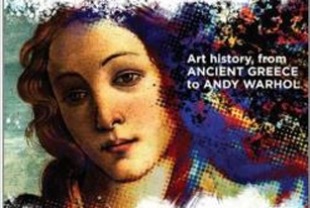In The Re-enchantment of Everyday Life, bestselling author Thomas Moore writes about the potential of art to transform us and the way we see the world:
"When we make our pilgrimage to the museum, we find images showing what the soul is made of, what my soul is made of. We celebrate those artists who powerfully and beautifully paint the secret sources of our lives. The images, so carefully made, educate our imagination in the precision, depth, range, and focus of human life. In a museum we see more of our souls than we could find through any means of introspective analysis."
Welcome to Art of the Western World, a nine-part documentary series which originally aired on PBS and is now available as a 3 DVD set. Extras include a a 20-page Viewer's Guide with interviews with the producers, articles, and a timeline, plus biographies of many of the major artists, and fun facts about oil paints, poems by Michelangelo, and more discussion questions at athenalearning.com.
The timespan for this series, which was filmed in 150 locations and 8 countries, covers a 2,500 year period from ancient Greece of antiquity to the pop art of Andy Warhol in modern America during the 1980s. Oxford-educated Michael Wood hosts this ambitious and unprecedented series about the painting, sculpture, and architecture of Western culture. He points out how Western art mirrors Western culture, often providing the historical and social context for a particular piece.
Art of the Western World is divided into nine episodes, which give you an idea of its scope:
• 1. The Classical Ideal
• 2. A White Garment of Churches: Romanesque and Gothic Art
• 3. The Early Renaissance
• 4. The High Renaissance
• 5. Realms of Light: The Baroque
• 6. An Age of Reason, an Age of Passion
• 7. A Fresh View: Impressionism and Postimpressionism
• 8. Into the 20th Century
• 9. In Our Own Time
In each program, historians and scholars share commentaries on the times and the artists. The sumptuous camera work brings us very close to the art or sculpture so we have a feel for the sensuous quality of these creations. Wood makes a great host, genuinely conveying his enthusiasm for art, creativity, and imagination.
Throughout the nine hours of Art of the Western World, we had the same response as Thomas Moore did when he visits museums: we felt our souls come alive while viewing art by Michelangelo, Bernini, Goya, Van Gogh, and Miro. Wood engaged us in such a way that our faculty of reverie was called into play. In moments, we were reminded that a work of art brings out "the radiance." We want to linger and enjoy the painting or sculpture, or architecture.
Another spiritual lesson we picked up while watching this production was the ways in which artists give us a new respect for the commonplace, all the trivial things and events of life. Art slows us down in our tracks and lets us see the miraculous beauty in the minutia surrounding us.
We tried a spiritual practice by Zen writer Gary Thorp and it worked quite well:
"Sometimes when I stand before a work of art, I will close my eyes and then reopen them. The image before me becomes reborn with fresh appearance and renewed color, and I often see the painting or drawing in a different way."
Try it and see what happens for you.
One of the many delights in viewing Art of the Western World on DVD is the chance to watch the episodes at your own speed, taking breaks when you want to allow impressions to sink into your mind and senses. Here's a process suggested by Shaun McNiff, one of the Living Spiritual Teachers profiled on Spirituality & Practice:
"The simple process of looking is the most innate way of responding to art. This is what we do when we visit a gallery or museum. Sit down with your art and take the time to contemplate its visual qualities.
"Take these expressions inside yourself.
"The pictures carry medicines, energies, creative spirits, and vitality that they will give to you freely.
"Open yourself to them and let them soothe your emotions and activate your passions."
